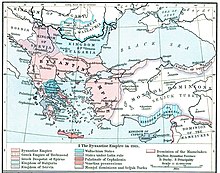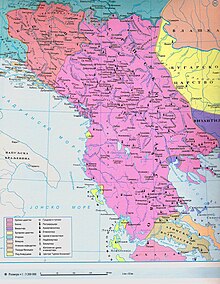This is an old revision of this page, as edited by Donatus (talk | contribs) at 05:52, 14 August 2007 (+hr). The present address (URL) is a permanent link to this revision, which may differ significantly from the current revision.
Revision as of 05:52, 14 August 2007 by Donatus (talk | contribs) (+hr)(diff) ← Previous revision | Latest revision (diff) | Newer revision → (diff)| The article's lead section may need to be rewritten. Please help improve the lead and read the lead layout guide. (Learn how and when to remove this message) |
| This article needs to be divided into sections. Please help improve the article and read the Manual of Style for guidelines. |
Тhe Serbian medieval history begins in the 5th century AD with the coming of the slavs on the Balkans,and ends with the occupation of Serbia by the Ottoman Empire in 1459 with the fall of the Serbian capital Smederevo.
The coming of the Serbs on the Balkans
The Serbian people are the descendants of slavs.The Serbs entered their present territory early in the 7th century AD , settling in six distinct tribal delimitations:
- Rascia/Raška (present-day southern Serbia and northern Montenegro),
- Bosnia/Bosna (present-day south-central and southeastern Bosnia),
- Zachumlie/Zahumlje (western Herzegovina),
- Trebounia/Travunija (eastern Herzegovina),
- Pagania/Paganija (middle Dalmatia) and finally
- Duklja/Zeta (predecessor to Montenegro).
These districts were mostly under the control of the Byzantine Empire.
Early State
The early days of the Serbian state are mostly unknown. The first recorded Serb princes were Vlastimir, Višeslav, Radoslav and Prosigoj. By that time, the country had entirely accepted Christianity,and was under the Byzantium Empire. In Zeta, today's Montenegro, Mihailo was crowned by the Pope, and his son Bodin reclaimed the throne. The rulers kept changing and the country accepted supreme protection from the Byzantine Empire rather than from hostile Bulgaria. It is recorded that the Bulgarians attacked Serbia many times,but by the end,both the Bulgarians and Serbians lived in peace under the Byzantium empire.
The first unified Serb state emerged under Caslav Klonimirovic in the mid-10th century in Rascia, but the state was still subordinated tot he Byzantium empire. This state would last until the 12th century when Serbia tried to free itself,but without success . But on 1166 Stefan Nemanja came to power. He too, like the former rulers of Serbia ,is trying to find a way to make Rascia independent. During the Byzantium-Venice wars,Stefan Nemanja declares independence, but Byzantium manages to end the war with Venice,and invades Serbia. Stefan Nemanja surrenders and is taken away to Constantinople and later reigns as a puppet king. But with the death of the Byzantium emperor,Stefan Nemanja manages to conquer Zeta (present day Montenegro), then Kosovo,parts of Macedonia and the eastern parts of today's Serbia. Byzantium tries to recapture the lands,but fails. Stefan Nemanja ruled until 1195 when he stepped down from the throne and appointed his son,Stefan I,as the ruler of Serbia.

The reign of the Nemanjic
Stefan Nemanja was succeeded by his middle son Stefan, whilst his first-born son Vukan was given the rule of the Zeta region (present-day Montenegro). Stefan Nemanja’s youngest son Rastko became a monk and took the name of Sava, turning all his efforts to spreading religion among his people. Since the Curia already had ambitions to spread its influence to the Balkans as well, Stefan used these propitious circumstances to obtain his crown from the Pope, thereby becoming the first Serbian king, in 1217. In Byzantium, his brother Sava managed to secure the autocephalous status for the Serbian Church and became the first Serbian archbishop in 1219. Thus the Serbs acquired both forms of independence: temporal and religious.

The next generation of Serbian rulers — the sons of Stefan Prvovencani — Radoslav, Vladislav and Uroš I, marked a period of stagnation of the state structure. All three kings were more or less dependent on some of the neighbouring states — Byzantium, Bulgaria or Hungary. The ties with the Hungarians had a decisive role in the fact that Uroš I was succeeded by his son Dragutin whose wife was a Hungarian princess. Later on, when Dragutin abdicated in favour of his younger brother Milutin (in 1282), the Hungarian king Ladislaus IV gave him lands in northeastern Bosnia, the region of Mačva, and the city of Belgrade, whilst he managed to conquer and annex lands in northeastern Serbia. Thus, some of these territories became part of the Serbian state for the first time. His new state was named Kingdom of Srem. In that time the name Srem was a designation for two territories: Upper Srem (present day Srem) and Lower Srem (present day Mačva). Kingdom of Srem under the rule of Stefan Dragutin was actually Lower Srem, but some historical sources mention that Stefan Dragutin also ruled over Upper Srem and Slavonia. After Dragutin died (in 1316), the new ruler of the Kingdom of Srem became his son, king Vladislav II, which ruled this state until 1325.

~ 1350 AD
Under the rule of Dragutin’s younger brother—King Milutin, Serbia grew stronger despite having to occasionally fight wars on three different fronts. King Milutin was an apt diplomat much inclined to the use of a customary medieval diplomatic expedients — dynastic marriages. He was married five times, with Hungarian, Bulgarian and Byzantine princesses. He is also famous for building churches, some of which are the brightest examples of Medieval Serbian architecture: the Gračanica monastery in Kosovo, the Cathedral in Hilandar Monastery on Mt. Athos, the St. Archangel Church in Jerusalem etc. Because of his endowments, King Milutin has been proclaimed a saint, in spite of his tumultuous life. He was succeeded on the throne by his son Stefan, later dubbed Stefan Decanski. Spreading the kingdom to the east by winning the town of Nis and the surrounding counties, and to the south by acquiring territories on Macedonia, Stefan Decanski was worthy of his father and built the Visoki Decani Monastery in Metohija—the most monumental example of Serbian Medieval architecture—that earned him his byname. Stefan Decanski defeated the Bulgarians in Battle of Velbužd in 1330.
Medieval Serbia enjoyed a high political, economic, and cultural reputation in Europe. It was one of the few states that did not practice the feudal order. Medieval Serbia reached its apex in the mid-14th century, during the rule of King Stefan Dusan,later do be crowned as the Tzar. This is the period of the golden age of the Serbian empire. One of the most greatest achievements of Stefan Dusan were the Dusanov Zakonik (Dusan's Code, 1349), a juridical achievement unique among the European states of the time ,the opening of new trade routes and strenghening the economy,and great conquests,which doubled the size of his kingdom,seizing territories to the south, southeast and east at the expense of Byzantium. Serbia flourished, featuring one of the most evolved countries and cultures in Europe. Some of Serbia’s greatest Medieval arts were created during this period, most notably St. Sava’s Nomocanon.
The downfall of the Serbian empire
Tzar Stefan Dusan however,died suddenly. He was succeeded by his son Uroš, called the Weak, a term that might also apply to the state of the kingdom, as it slowly slid into feudal anarchy. This is a period marked by the rise of a new threat: the Ottoman Turk sultanate gradually spreading from Asia to Europe and conquering Byzantium first, and then the other Balkans states. Serbia was carved between the feudal lords. The most powerful was Vukasin,also called King Vukasin,who was the right hand of Stefan Uros,but he died in the battle of the Marica river in his campaign to drive the Turks out of Europe.Tzar Uros died several months later,and with his death,the Nemanjic dynasty was over. However,a new figure emerged-Lazar Hrebeljanovic,who managed to unite most of Serbia with war and diplomacy. But however,some feudal lords were too powerful. But a new threat was rising-the Ottoman Empire.The first raids on Lazar's territory began in 1381,but the real invasion came in 1389.Lazar managed to gather every soldier he could,and ont he 28th of July 1389 the two armies met in Kosovo,in what is to become known as Battle of Kosovo.The details of the battle are not clear, but we know that the Serbian forces were outnumbered. The attack began with the Serbians penetrating the first 2 lines of the Turkish army, and completely destroyed the right flank,under the command of the sultan's son, Jacub. At one point in the battle, a Serbian knight called Milos Obilic deserted the army and went over to the Turkish side. There he managed to assassinate the Ottoman sultan, Murad II. His son, Bayazit, took command of the army and manage to defeat the Serbs and to capture King Lazar and execute him. The losses are unknown,but it is said that almost the entire Serbian army was routed. Turkish losses were also very high,and they did not advance into Serbia. Instead they turned back to face the rebellions in Asia Minor.Serbia managed to recuperate under the despot Stefan,but after his death, his successors couldn't stop the Ottoman advance. Serbia fell under the Ottomans in 1459,and stayed under their occupation until 1882,when Serbia was finally recognised as an independent state.

External links
| European Middle Ages | |
|---|---|
| Early Middle Ages |
|
| High Middle Ages |
|
| Late Middle Ages | |
| Culture | |
| Related | |
